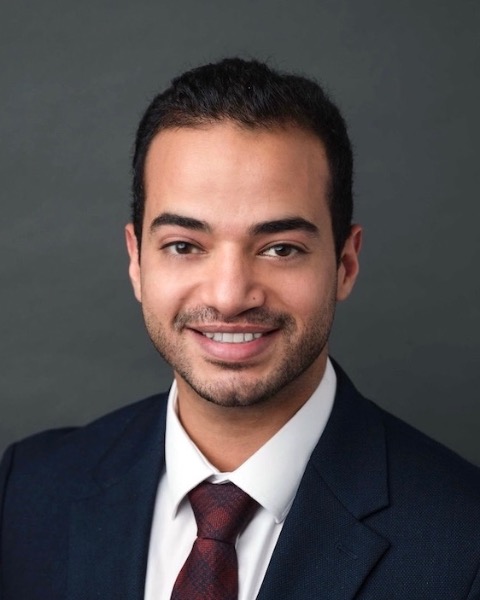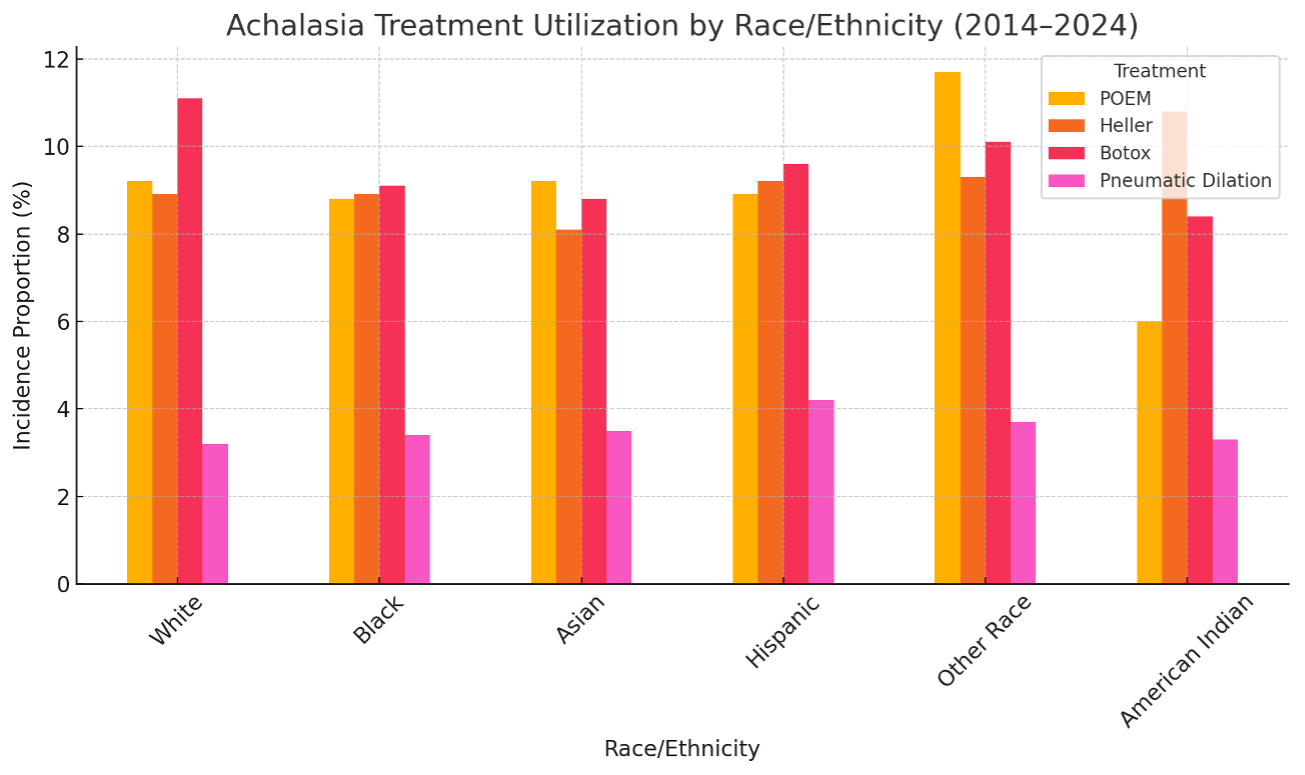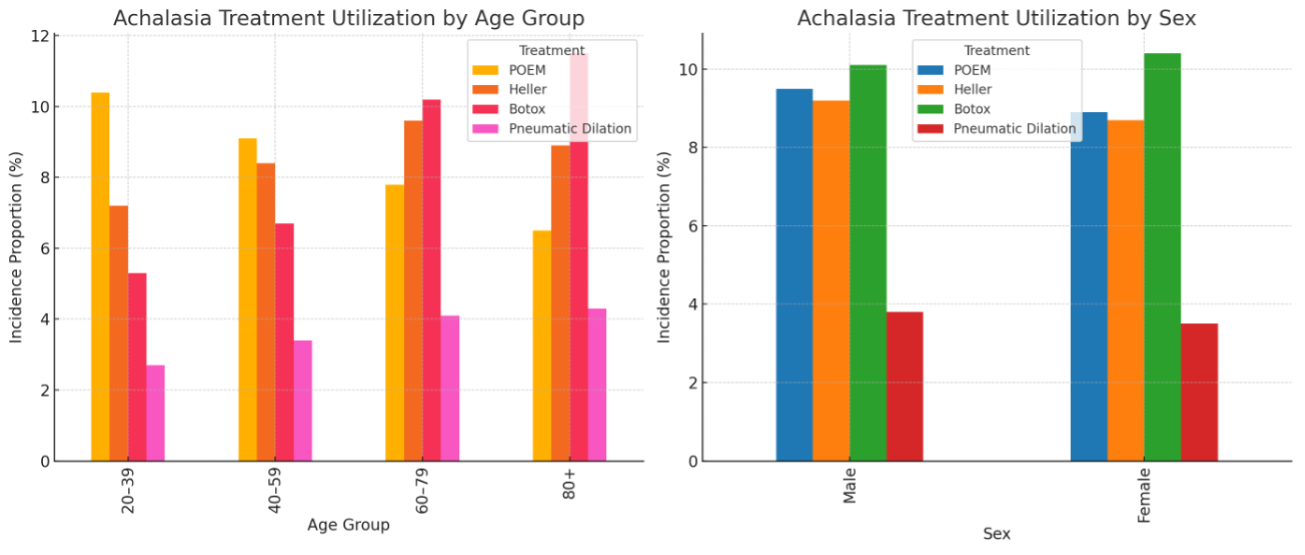Monday Poster Session
Category: Interventional Endoscopy
P3554 - Demographic Disparities in Achalasia Therapy Utilization: A Nationwide Cohort Analysis (2014-2024)
Monday, October 27, 2025
10:30 AM - 4:00 PM PDT
Location: Exhibit Hall

Mohammad AbuAssi, MD (he/him/his)
University of Central Florida, HCA Healthcare GME
Gainesville, FL
Presenting Author(s)
Mohammad Abuassi, MD1, Razan Aburumman, MD2, Carson Creamer, DO1, Mohammad Al-Ani, MD3, Tony Brar, MD4, Mahmoud Y. Madi, MD5, Yaseen Perbtani, DO1
1University of Central Florida, HCA Healthcare GME, Gainesville, FL; 2Henry Ford Health, Detroit, MI; 3University of Jordan School of Medicine, Amman, 'Amman, Jordan; 4University of Central Florida, Gainesville, FL; 5University of Texas at Austin Dell Medical School, Austin, TX
Introduction: Achalasia is a rare esophageal motility disorder with multiple therapeutic options, including peroral endoscopic myotomy (POEM), laparoscopic Heller myotomy, pneumatic dilation, and botulinum toxin injection. Although POEM has gained prominence at specialized centers, its accessibility across demographic groups remains poorly understood, raising concerns about potential disparities. We conducted a nationwide analysis to evaluate procedural disparities in achalasia treatment based on race, ethnicity, age, and sex.
Methods: Using TriNetX, a database comprising de-identified electronic health records from over 100 healthcare systems. Adults diagnosed with achalasia between 2014 and 2024 were included, excluding those with esophageal or gastric malignancy. Treatment modalities, POEM, Heller myotomy, pneumatic dilation, and botox injection were identified using standardized procedure codes. Demographic variables included race, ethnicity, age group, and sex. For each subgroup, Incidence proportions were calculated as the number of treated patients divided by the total diagnosed with achalasia. Disparities were assessed descriptively by comparing treatment utilization across demographic strata.
Results: Among 47,881 patients with achalasia, we observed notable disparities in treatment allocation. POEM was more frequently performed among patients identifying as Other Race (11.7%) and Asian (9.2%), while Heller myotomy was more common among American Indian/Alaska Native patients (10.8%). Botox use was highest among White (11.1%) and Hispanic (9.6%) patients, while pneumatic dilation peaked in Hispanic patients (4.2%). Age disparities were pronounced: POEM utilization was highest in younger patients (10.4% in ages 20–39) and declined steadily with age, while Botox and pneumatic dilation were most frequently used in patients aged ≥80 (11.5% and 4.3%, respectively). Sex-based differences were minimal, though POEM and Heller were slightly more common in males.
Discussion: This national analysis reveals significant disparities in achalasia therapies across racial, ethnic, and age groups. POEM, the most rapidly adopted modality, is disproportionately used in younger and non-Black populations, whereas older and minority patients are more likely to receive Botox or pneumatic dilation. These disparities likely reflect clinical, healthcare accessibility, and systemic factors. As treatments advance, ensuring equitable access to all guideline-based achalasia therapies remains a critical priority.

Figure: Incidence proportions of POEM, Heller myotomy, Botox, and pneumatic dilation stratified by race and ethnicity. POEM was most commonly utilized among patients identified as Other Race (11.7%) and Asian (9.2%), while Heller myotomy was highest in American Indian/Alaska Native patients (10.8%). Botox use was most frequent among White (11.1%) and Hispanic (9.6%) populations. Pneumatic dilation rates were lowest across all groups but most used among Hispanic patients (4.2%).

Figure: Left panel: Treatment utilization stratified by age group shows POEM was most common among patients aged 20–39, while botulinum toxin injection and pneumatic dilation were more frequently used in those aged ≥80 years. Right panel: Sex-based comparison indicates minimal differences overall, with slightly higher use of POEM and Heller myotomy in males and a marginally higher use of Botox in females.
Disclosures:
Mohammad Abuassi indicated no relevant financial relationships.
Razan Aburumman indicated no relevant financial relationships.
Carson Creamer indicated no relevant financial relationships.
Mohammad Al-Ani indicated no relevant financial relationships.
Tony Brar indicated no relevant financial relationships.
Mahmoud Madi indicated no relevant financial relationships.
Yaseen Perbtani indicated no relevant financial relationships.
Mohammad Abuassi, MD1, Razan Aburumman, MD2, Carson Creamer, DO1, Mohammad Al-Ani, MD3, Tony Brar, MD4, Mahmoud Y. Madi, MD5, Yaseen Perbtani, DO1. P3554 - Demographic Disparities in Achalasia Therapy Utilization: A Nationwide Cohort Analysis (2014-2024), ACG 2025 Annual Scientific Meeting Abstracts. Phoenix, AZ: American College of Gastroenterology.
1University of Central Florida, HCA Healthcare GME, Gainesville, FL; 2Henry Ford Health, Detroit, MI; 3University of Jordan School of Medicine, Amman, 'Amman, Jordan; 4University of Central Florida, Gainesville, FL; 5University of Texas at Austin Dell Medical School, Austin, TX
Introduction: Achalasia is a rare esophageal motility disorder with multiple therapeutic options, including peroral endoscopic myotomy (POEM), laparoscopic Heller myotomy, pneumatic dilation, and botulinum toxin injection. Although POEM has gained prominence at specialized centers, its accessibility across demographic groups remains poorly understood, raising concerns about potential disparities. We conducted a nationwide analysis to evaluate procedural disparities in achalasia treatment based on race, ethnicity, age, and sex.
Methods: Using TriNetX, a database comprising de-identified electronic health records from over 100 healthcare systems. Adults diagnosed with achalasia between 2014 and 2024 were included, excluding those with esophageal or gastric malignancy. Treatment modalities, POEM, Heller myotomy, pneumatic dilation, and botox injection were identified using standardized procedure codes. Demographic variables included race, ethnicity, age group, and sex. For each subgroup, Incidence proportions were calculated as the number of treated patients divided by the total diagnosed with achalasia. Disparities were assessed descriptively by comparing treatment utilization across demographic strata.
Results: Among 47,881 patients with achalasia, we observed notable disparities in treatment allocation. POEM was more frequently performed among patients identifying as Other Race (11.7%) and Asian (9.2%), while Heller myotomy was more common among American Indian/Alaska Native patients (10.8%). Botox use was highest among White (11.1%) and Hispanic (9.6%) patients, while pneumatic dilation peaked in Hispanic patients (4.2%). Age disparities were pronounced: POEM utilization was highest in younger patients (10.4% in ages 20–39) and declined steadily with age, while Botox and pneumatic dilation were most frequently used in patients aged ≥80 (11.5% and 4.3%, respectively). Sex-based differences were minimal, though POEM and Heller were slightly more common in males.
Discussion: This national analysis reveals significant disparities in achalasia therapies across racial, ethnic, and age groups. POEM, the most rapidly adopted modality, is disproportionately used in younger and non-Black populations, whereas older and minority patients are more likely to receive Botox or pneumatic dilation. These disparities likely reflect clinical, healthcare accessibility, and systemic factors. As treatments advance, ensuring equitable access to all guideline-based achalasia therapies remains a critical priority.

Figure: Incidence proportions of POEM, Heller myotomy, Botox, and pneumatic dilation stratified by race and ethnicity. POEM was most commonly utilized among patients identified as Other Race (11.7%) and Asian (9.2%), while Heller myotomy was highest in American Indian/Alaska Native patients (10.8%). Botox use was most frequent among White (11.1%) and Hispanic (9.6%) populations. Pneumatic dilation rates were lowest across all groups but most used among Hispanic patients (4.2%).

Figure: Left panel: Treatment utilization stratified by age group shows POEM was most common among patients aged 20–39, while botulinum toxin injection and pneumatic dilation were more frequently used in those aged ≥80 years. Right panel: Sex-based comparison indicates minimal differences overall, with slightly higher use of POEM and Heller myotomy in males and a marginally higher use of Botox in females.
Disclosures:
Mohammad Abuassi indicated no relevant financial relationships.
Razan Aburumman indicated no relevant financial relationships.
Carson Creamer indicated no relevant financial relationships.
Mohammad Al-Ani indicated no relevant financial relationships.
Tony Brar indicated no relevant financial relationships.
Mahmoud Madi indicated no relevant financial relationships.
Yaseen Perbtani indicated no relevant financial relationships.
Mohammad Abuassi, MD1, Razan Aburumman, MD2, Carson Creamer, DO1, Mohammad Al-Ani, MD3, Tony Brar, MD4, Mahmoud Y. Madi, MD5, Yaseen Perbtani, DO1. P3554 - Demographic Disparities in Achalasia Therapy Utilization: A Nationwide Cohort Analysis (2014-2024), ACG 2025 Annual Scientific Meeting Abstracts. Phoenix, AZ: American College of Gastroenterology.
